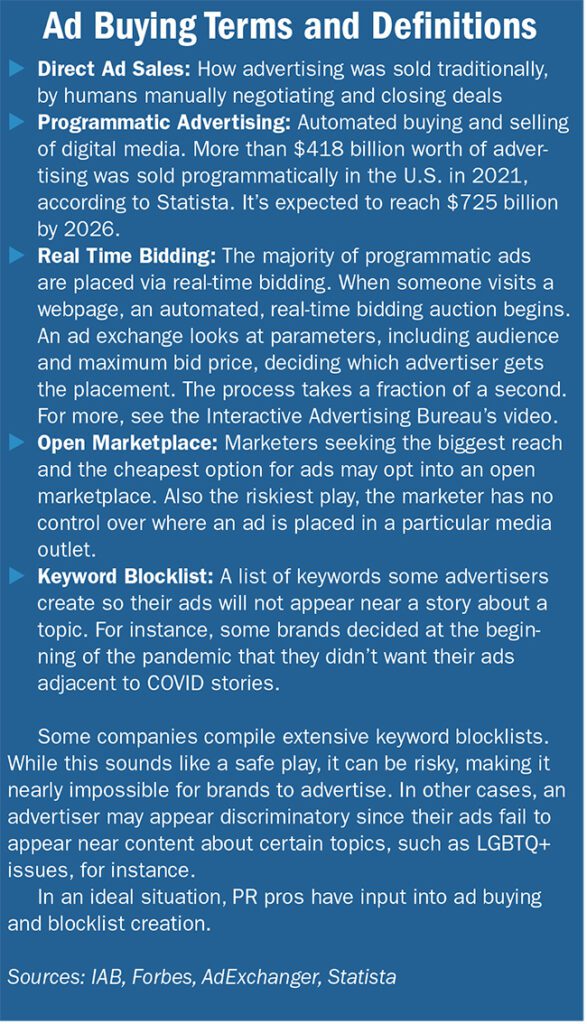
With the explosion of misinformation and an increasingly frenetic news cycle, it's important for marketers to know the exact location of their ads. And, if you're buying ads programmatically (see definition chart below), it can be difficult to know exactly where they'll run.
Compound that with an uptick in organizations’ mishaps going viral on social and the rise of industry watchdogs, and companies may face a reputation hit if their ads are poorly targeted or news events render them inappropriate.
A recent study from ad verification company Integral Ad Science (IAS) says 42 percent of digital-media experts worry about how advertising alongside misinformation could damage a company's reputation. From the same study, 45 percent say ads adjacent “to content unsuitable for a brand” is their biggest quality concern.
Yet the definition of unsuitable content differs from company to company. Only some marketers reevaluate their blocklists and ad spending after major news events.
“You just know putting things on CNN, Fox News, or any sort of potentially politicized outlet...is a higher risk," says Brad Chase, founder at Seattle-based communications firm Chase Global.
He adds, "So, unless your product is clearly targeted and you’ll never be in the wrong," marketers should consider if the return is strong enough that it’s worth the risk of alienating people.
Anthony Barranco, North American digital media lead at HP, says,“Content adjacency is certainly something we bake into our planning.” He concedes there's risk associated with advertising on news sites with a political stance. Still, "in some cases our audiences are avid news consumers and index high on certain news sites. So, this is a place we need to be to achieve effective reach.”
Says Jonathon Narvey, CEO of Vancouver-based Mind Meld PR, “Let's say a marketing team has a hunch that it's going to be all bad news, all day long for the next 24 to 48 hours. They decide to put their advertising on hold…Fair enough. This is a safe play. But is the company playing it too safe?”
Below, we explore:
- How and when marketers and communicators should discuss media buys
- How, in such a politically divided environment, companies can ensure they don’t get caught in the crossfire of a divisive issue and
- Whether there is ever a point at which a company should respond to ad placements gone awry
In this Together
While marketing, advertising and communication have, in some ways, become more connected, in other respects they continue to be separate. As such, marketing and communication don’t always agree. Moreover, their goals differ.
In short, marketers work for sales. Corporate reputation is the PR pro’s objective.
Not surprisingly, it’s best when marketing and communication coordinate from the outset on media buying.
"We’re always looking at media from a PR lens," says Ivanka Farrell, managing director at Bully Pulpit Interactive, who oversees paid media strategy at the public affairs consultancy. She admits such an arrangement is not always the case.
"The best way to make it the norm," Farrell says, "is to show what value PR brings to paid media–whether that is identifying an opportunity that paid media should capitalize on or one to avoid."
Says Chase, “the key is upfront trust." Marketing and communication must recognize "they each know what they don't know and that both departments need to work in unison.”
It starts with building relationships and setting up ground rules between departments.
“There’s no need to run every little thing...by each other, but each needs to flag distribution channels just so the other is aware,” says Chase.
In an ideal situation, the initial campaign discussion would include “key players responsible for every element,” says Linda Pophal, founder of marketing and communication firm Strategic Communications LLC. This includes team members from social, copy, graphic design, media buying and legal, in addition to the subject matter expert or brand manager.
Farrell says the amount of coordination between marketing and PR should depend on the "volume and content of the campaign." At the least, she advises quarterly meetings.
As a practical matter, it's best when marketing shares intended outlets with PR. Another practical tactic for risk-averse brands: advertise on networks like AMC or Bravo, for example, instead of CNN or Fox.
Reconsider Blocklists
In addition to where ads go, PR should consider the what and whether there are any keywords to add to the blocklist.
"The PR team is newsjacking all week long. So they'll have a good sense of what's happening in the news cycle that's outside of the regular day-to-day of marketing operations," says Narvey. "It's not really the PR person's job to review blocklisted keywords, but from a high-level conceptual framework, they can provide the ad managers with ideas of current (or trending) news that might require a temporary change in approach."
Farrell agrees, and adds that communicators can suggest additions to blocklists for key moments.
In general, though, she recommends that marketers "look at their buys from a PR perspective and ask, 'If my ad showed up next to this story and someone screenshot and tweeted it, how would that make the brand look?'"
For example, at the beginning of the pandemic, some brands were blocking all keywords related to the coronavirus, ensuring they wouldn't be adjacent to stories about COVID.
But it's important to consider context. A 2020 IAS study found consumers believe that "the appropriateness of coronavirus ad adjacency 'depends on the brand'...More specifically, consumers most want to see health/pharma, government and educational ads in coronavirus adjacencies while they least want to see travel, food/beverage and finance brands alongside this type of content."
And, of course, there's the when. While marketers can identify product cycles, communicators should weigh in on times of the year to avoid certain campaigns.
Pophal offers an example where an energy company placed an ad depicting every light in a home on. “This was during a time when energy conservation was [widely discussed]” in the media. It’s something that PR would have flagged, she says.
Risk Mitigation
Of course, there are news moments that cannot be predicted. “There is so much going on out there, every ad is susceptible to content it’s attached to,” Chase says.
As noted, each company decides what level of risk it's willing to take.
And the inevitable will occur. "No matter what, you’re going to get dinged for something and you’ll have people on the far left or right [complaining]. If you’re not fast enough to [address it], you’ll be criticized.’”
As such, he believes PR and marketing should work together on a response. This is not a full crisis plan, he says. Still, PR can help. Some marketers "don't recognize risk mitigation as something that needs to be part of a marketing plan," he says.
Fortunately, that's where communicators can help.

